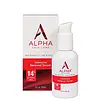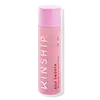What's inside
What's inside
 Key Ingredients
Key Ingredients

 Benefits
Benefits

 Concerns
Concerns

 Ingredients Side-by-side
Ingredients Side-by-side

Water
Skin ConditioningGlycolic Acid
BufferingAmmonium Hydroxide
BufferingGlycerin
HumectantPropylene Glycol
HumectantChamomilla Recutita Extract
Skin ConditioningCamellia Sinensis Leaf Extract
AntimicrobialSodium Hyaluronate
HumectantAloe Barbadensis Leaf Juice
Skin ConditioningWheat Germamidopropyldimonium Hydroxypropyl Hydrolyzed Wheat Protein
Cellulose Gum
Emulsion StabilisingDiazolidinyl Urea
PreservativeIodopropynyl Butylcarbamate
PreservativeWater, Glycolic Acid, Ammonium Hydroxide, Glycerin, Propylene Glycol, Chamomilla Recutita Extract, Camellia Sinensis Leaf Extract, Sodium Hyaluronate, Aloe Barbadensis Leaf Juice, Wheat Germamidopropyldimonium Hydroxypropyl Hydrolyzed Wheat Protein, Cellulose Gum, Diazolidinyl Urea, Iodopropynyl Butylcarbamate
Water
Skin ConditioningGlycolic Acid
BufferingGlycerin
HumectantCaprylic/Capric Triglyceride
MaskingSodium Hydroxide
BufferingFragaria Vesca Fruit Extract
AstringentAvena Sativa Seed Extract
Skin ConditioningLactobacillus Ferment
Skin ConditioningJojoba Esters
EmollientPolyglyceryl-6 Caprylate
EmulsifyingPolyglyceryl-3 Cocoate
EmulsifyingPolyglyceryl-4 Caprate
EmulsifyingPolyglyceryl-6 Ricinoleate
EmulsifyingRubus Fruticosus Fruit Extract
AstringentRubus Occidentalis Fruit Extract
AstringentPyrus Malus Fruit Extract
Skin ConditioningSodium Hyaluronate
HumectantAnanas Sativus Fruit Extract
Skin ConditioningArginine
MaskingCaprylyl Glycol
EmollientIsopropyl Jojobate
EmollientAllantoin
Skin ConditioningTocopherol
AntioxidantPanthenol
Skin ConditioningSodium Acrylates Copolymer
Ethylhexylglycerin
Skin ConditioningHexylene Glycol
EmulsifyingLecithin
EmollientDecyl Glucoside
CleansingSilica
AbrasiveBisabolol
MaskingLauryl Glucoside
CleansingPotassium Sorbate
PreservativeSodium Benzoate
MaskingCitric Acid
BufferingPhenoxyethanol
PreservativeOctyldodecanol
EmollientXanthan Gum
EmulsifyingCI 77891
Cosmetic ColorantMica
Cosmetic ColorantCI 77491
Cosmetic ColorantWater, Glycolic Acid, Glycerin, Caprylic/Capric Triglyceride, Sodium Hydroxide, Fragaria Vesca Fruit Extract, Avena Sativa Seed Extract, Lactobacillus Ferment, Jojoba Esters, Polyglyceryl-6 Caprylate, Polyglyceryl-3 Cocoate, Polyglyceryl-4 Caprate, Polyglyceryl-6 Ricinoleate, Rubus Fruticosus Fruit Extract, Rubus Occidentalis Fruit Extract, Pyrus Malus Fruit Extract, Sodium Hyaluronate, Ananas Sativus Fruit Extract, Arginine, Caprylyl Glycol, Isopropyl Jojobate, Allantoin, Tocopherol, Panthenol, Sodium Acrylates Copolymer, Ethylhexylglycerin, Hexylene Glycol, Lecithin, Decyl Glucoside, Silica, Bisabolol, Lauryl Glucoside, Potassium Sorbate, Sodium Benzoate, Citric Acid, Phenoxyethanol, Octyldodecanol, Xanthan Gum, CI 77891, Mica, CI 77491
Ingredients Explained
These ingredients are found in both products.
Ingredients higher up in an ingredient list are typically present in a larger amount.
Glycerin is already naturally found in your skin. It helps moisturize and protect your skin.
A study from 2016 found glycerin to be more effective as a humectant than AHAs and hyaluronic acid.
As a humectant, it helps the skin stay hydrated by pulling moisture to your skin. The low molecular weight of glycerin allows it to pull moisture into the deeper layers of your skin.
Hydrated skin improves your skin barrier; Your skin barrier helps protect against irritants and bacteria.
Glycerin has also been found to have antimicrobial and antiviral properties. Due to these properties, glycerin is often used in wound and burn treatments.
In cosmetics, glycerin is usually derived from plants such as soybean or palm. However, it can also be sourced from animals, such as tallow or animal fat.
This ingredient is organic, colorless, odorless, and non-toxic.
Glycerin is the name for this ingredient in American English. British English uses Glycerol/Glycerine.
Learn more about GlycerinGlycolic Acid is arguably the most famous alpha hydroxy acid (AHA) with tons of research backing its benefits.
It is found naturally in sugar cane but the form used in skincare is usually synthetic for purity and stability.
Glycolic acid removes the top layer of dead skin cells to allow newer and fresher ones to emerge.
AHAs work by breaking down the structural “glue” that holds old skin cells in place. When that buildup is gone, your skin can renew itself more efficiently.
Research also shows glycolic acid stimulates collagen production, helping to firm and thicken the skin over time. This is one of its biggest advantages over other AHAs.
Overall, glycolic acid helps with:
Fun fact: Glycolic acid boosts skin hydration by helping it produce molecules that increase hyaluronic acid naturally.
To work best, glycolic acid products should have a pH between 3-4 (that’s where exfoliation is most effective but still gentle on skin).
The pH and concentration of a product are key to its effectiveness:
It is normal to feel a slight stinging sensation when using glycolic acid. This usually fades as your skin adjusts.
Because glycolic acid has the smallest molecular size in the AHA family, it can penetrate deeper, which enhances its effectiveness but also makes it more likely to irritate sensitive skin.
If your skin is very sensitive or prone to rosacea, glycolic acid may be too strong; in that case, try milder options like lactic acid or a PHA instead.
Recent studies suggest glycolic acid might even help protect against UV damage. But don’t skip sunscreen! Freshly exfoliated skin is more sensitive to the sun.
Glycolic acid is a skincare superstar. It smooths, brightens, hydrates, and firms the skin. Unless you’re highly sensitive, it’s well worth adding to your routine.
Read more about some other popular AHA's here:
Learn more about Glycolic AcidSodium Hyaluronate is hyaluronic acid's salt form. It is commonly derived from the sodium salt of hyaluronic acid.
Like hyaluronic acid, it is great at holding water and acts as a humectant. This makes it a great skin hydrating ingredient.
Sodium Hyaluronate is naturally occurring in our bodies and is mostly found in eye fluid and joints.
These are some other common types of Hyaluronic Acid:
Learn more about Sodium HyaluronateWater. It's the most common cosmetic ingredient of all. You'll usually see it at the top of ingredient lists, meaning that it makes up the largest part of the product.
So why is it so popular? Water most often acts as a solvent - this means that it helps dissolve other ingredients into the formulation.
You'll also recognize water as that liquid we all need to stay alive. If you see this, drink a glass of water. Stay hydrated!
Learn more about Water